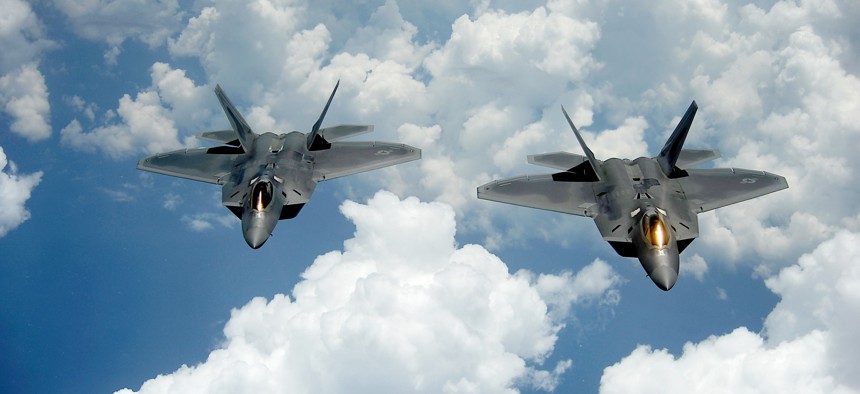
The new AIM-260 missile will eventually arm the Air Force's F-22 Raptors. U.S. Air Force / Master Sgt. Jeremy Lock
Will America's Next Long-Range Air-to-Air Missile Match Up to China's?
The Air Force says the AIM-260 won't be powered by a ramjet. Does it have another trick up its sleeve?
The U.S. military, and its Air Force in particular, invests in and places considerable store by superior technology to prevail against peer rivals. The service is also disinclined to allow its near-allies to field capabilities it does not also have access to. In the Air Force’s slipstream, U.S. industry is often first to market with advanced systems. This makes the USAF’s apparent approach to its next generation of beyond-visual-range air-to-air missiles all the more intriguing.
In 2022, Air Force officials plan to introduce a replacement for Raytheon’s AIM-120 Advanced Medium-Range Air-to-Air Missile, which for nearly three decades represented the West’s benchmark for active-radar-guided missile performance. The replacement — Lockheed Martin’s AIM-260 Joint Advanced Tactical Missile — has quietly been the service’s top development priority in the air-to-air sphere.
But while the AIM-260 undoubtedly offers marked improvements over its predecessor, including in overall range, there are questions about whether the new missile actually offers a longer useful range than the AIM-120 — or compared to other countries’ late-generation weapons.
Related: US Air Force to Shift Billions of Dollars to Network Its Weapons
Related: Air Force to Begin Shifting Research Funds to These Kinds of Next-Gen Weapons
Related: US Air Force Is Redrawing Its Pacific-War Playbook for China
Two years ago, Raytheon’s product was replaced as the West’s premier radar-guided air-to-air missile by the extended-range version of MBDA’s Meteor. The European missile has greater range, and more importantly, remains powered during the final stage of a medium- to long-range engagement.
This is because the AIM-120 is powered by a solid rocket, while the Meteor uses a ramjet sustainer engine. While the former has a higher top speed — it can briefly surpass Mach 4 — its solid propellant burns out faster that a ramjet’s, even with a boost-sustain motor configuration. The Meteor is thought to have fuel to operate for at least 60 seconds and a faster average speed.
All other things being equal, this gives the ramjet sustainer missile a far greater “no-escape zone” than a traditional solid-propellant missile. (The no-escape zone is the space in front of a launch aircraft within which the target aircraft can be engaged no matter what evasive maneuver it tries.) At medium ranges, a traditional solid-propellant missile is already coasting, making it easier for its target to outmaneuver or outrun it. The Meteor is described as having an operational range greater than 100 kilometers, and a 60-km no-escape zone.
While Europe’s missile may represent a competitive threat to U.S. industry, China is introducing missiles that might one day meet U.S. warplanes in battle. Last year saw the service introduction of the PL-15, which has a greater range than the AIM-120 family.
How does the U.S. Air Force intend to defeat enemy aircraft armed with better missiles? It’s not clear.
It’s not yet publicly known how the AIM-260 will be powered. But despite some four decades of rather sporadic research into anti-air ramjet propulsion, the U.S. Air Force has ruled out using a ramjet. That’s according to Air Force’s program executive officer for weapons, Brig. Gen. Anthony Genatempo, who has also indicated that the weapon would be no larger than the AIM-120.
Perhaps Lockheed Martin has come up with a novel propulsion approach for the AIM-260. Maybe it has a “boost-coast-boost” configuration that allowed the missile to engage its targets with more energy, or runs on a higher-energy propellant than previous generations of solid motors. Even so, it remains questionable whether such advances could match the performance of a Meteor-class missile.
Alternatively, the Air Force could rely on the combination of its new AIM-260 with low-observable launch platforms — the F-22 and, to a lesser extent, the F-35 — to defeat aircraft with notionally longer-range missiles. Such an approach, however, will not work with the fourth-generation F-15 and F-16 jets.
So perhaps the Air Force has an as-yet-undisclosed development that will provide its warplanes with a much longer-range engagement weapon. Or perhaps it has not.




